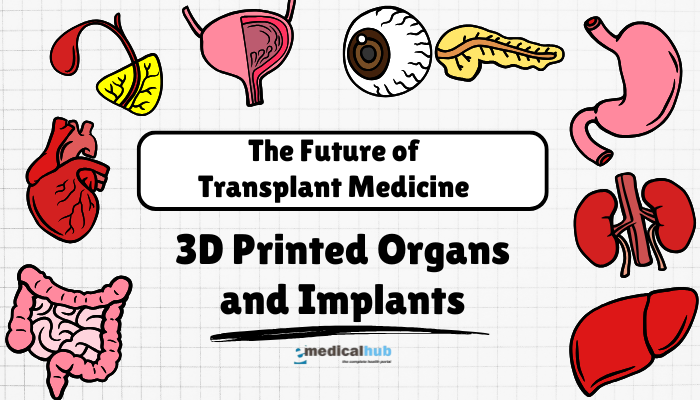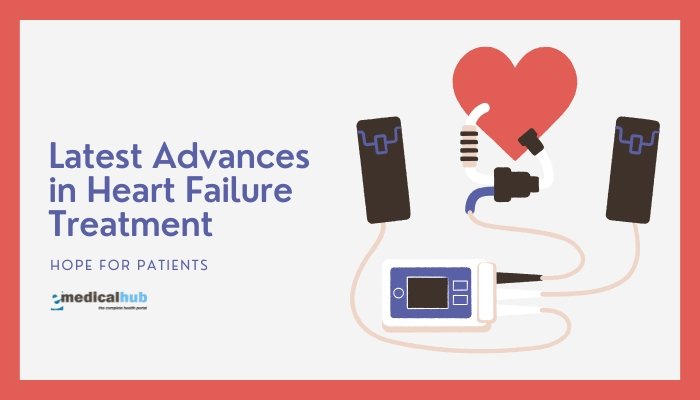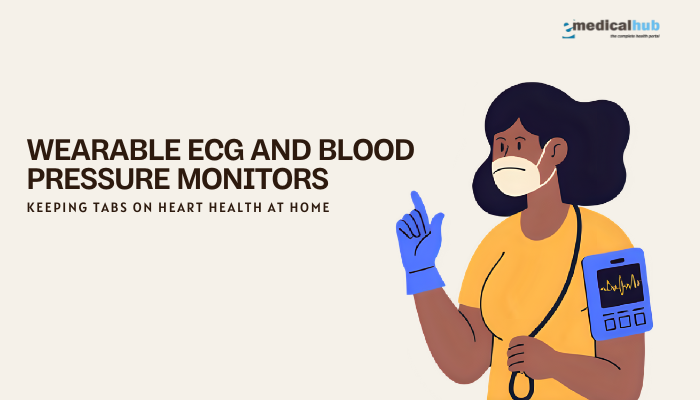Introduction
3D printing, sometimes called additive manufacturing, creates three-dimensional objects layer by layer using digital models. In recent years, researchers have tested 3D printing in the field of healthcare. They aim to produce organs, implants, and tissues that can replace or support failing body structures.
This method may help solve the shortage of donor organs and reduce risks connected to transplant rejections.
Medical professionals hope that personalized 3D printed implants can reduce complications and improve patient recovery. Engineers can model a patient’s anatomy using imaging data, such as computed tomography (CT) or magnetic resonance imaging (MRI).
Then they design personalized implants or organ scaffolds. Biocompatible materials, including certain plastics, metals, and biological “inks,” are used. While the technology is still evolving, it has already produced promising results in orthopedics, cardiology, and regenerative medicine.
This article explores how 3D printed organs and implants may shape the future of transplant medicine. It describes the basic principles, methods, applications, benefits, and current challenges. Readers will learn how 3D printing works, the regulatory framework needed, ethical considerations, and the possible direction of this research.
Foundations of 3D Printing for Medical Use
What Is 3D Printing?
3D printing builds items one layer at a time according to a digital plan. In medicine, designers often use the following steps:
• Data Collection: Doctors gather imaging scans of patient organs or bones.
• Digital Model: Specialists convert these images into a 3D computer model.
• Material Selection: They pick substances that match the organ’s structural or functional needs, such as metal for orthopedic implants or hydrogel for tissues.
• Layer-by-Layer Construction: The 3D printer deposits thin layers of material according to the design, bonding each layer together.
Bioprinting vs. Traditional 3D Printing
• Traditional 3D Printing: In healthcare, it uses plastics or metals to create implants, surgical guides, or prosthetics.
• Bioprinting: In this approach, cells and biomaterials (“bio-inks”) form scaffolds or functional tissues. Bioprinters keep cells alive during printing. Over time, these cells grow, mature, and form tissue structures.
Quote: A researcher in regenerative medicine said, “3D printing won’t replace every medical procedure, but it may reinvent how we treat organ failure and severe injuries in the decades to come.”
Materials Used in 3D Printing for Medicine
• Plastics (e.g., polylactic acid, polyether ether ketone): Often used for lightweight and custom-shaped implants or surgical guides.
• Metals (e.g., titanium alloys, stainless steel): Common in orthopedic or dental implants because of their strength and biocompatibility.
• Ceramics (e.g., hydroxyapatite): Ideal for bone regeneration due to their similarity to natural bone mineral.
• Hydrogels and Bio-Inks: May contain living cells, growth factors, or other biological molecules to support tissue formation.
Current Uses of 3D Printing in Healthcare
Surgical Tools and Guides
• Personalized Surgical Models: Before a complex surgery, doctors can print a replica of the affected organ or bone. This allows surgeons to plan incisions and practice procedures.
• Drill Guides: Printed templates can direct surgical tools with precision.
• Reduced Operating Time: Surgeons who rehearse using 3D models often operate faster and more confidently.
Implants and Prosthetics
• Cranial Implants: Custom implants restore skull sections after trauma or tumor removal.
• Joint Replacements: Patients with severe arthritis can receive a joint implant shaped to fit their anatomy.
• Prosthetic Limbs: Lower-cost prosthetic arms or legs, often for children, are produced quickly using 3D printing.
Dental and Maxillofacial Reconstruction
• Dental Crowns and Bridges: 3D printing can craft these to match a patient’s tooth structure.
• Jaw Reconstruction: Surgeons replace damaged or missing jawbone segments with printed implants that integrate well with existing bone.
Bioprinting for Tissue Engineering
• Skin Patches: Researchers explore layered skin printing for wound healing and burn treatments.
• Cartilage Structures: Bioprinted ear cartilage or meniscus tissue could restore function in patients with injuries.
• Early Organ Prototypes: Lab-grown mini-livers or kidney tissues tested in experimental settings.
Drug Delivery and Pharmaceutical Research
• Personalized Pills: Some groups investigate 3D printed tablets that combine multiple medications, customizing dosages and release times.
• Medical Device Testing: Scientists create tissue-like models to test drug effects or device performance.
Advancing Transplant Medicine with 3D Printing
Organ Shortage Crisis
• Limited Donors: Many patients wait months or years for a donor. Some do not survive the wait.
• Immunological Mismatch: Even if a match is found, the patient may experience organ rejection.
• High Healthcare Costs: Organ failure leads to repeated hospitalizations and expensive treatments.
Potential of 3D Printed Organs
• On-Demand Fabrication: In theory, labs could print an organ when needed.
• Reduced Rejection: If a patient’s cells are used, the new organ may reduce immune responses.
• Scalability: Once fully refined, 3D printing could potentially address large-scale transplant demands.
Bio-Ink Composition for Organ Printing
• Cells: Stem cells or patient-specific adult cells cultured in the lab.
• Biomaterials: Hydrogels that mimic the extracellular matrix.
• Growth Factors: Proteins that guide cell differentiation and tissue growth.
Steps in Printing an Organ
- Cell Harvesting: Obtain cells from the patient or an alternative source.
- Cell Expansion: Multiply the cells in culture.
- Bio-Ink Preparation: Mix these cells with a supportive hydrogel.
- Printing Process: Deposit the bio-ink in layers to form the organ’s shape.
- Maturation: Place the printed structure in a bioreactor that supplies nutrients, oxygen, and stimuli until it develops necessary features.
- Transplant: Once stable, the printed organ is implanted into the recipient.
Table: Comparison of Traditional Organ Transplant vs. 3D Printed Organ
| Feature | Traditional Organ Transplant | 3D Printed Organ |
| Donor Requirement | Requires deceased or living donor | Potentially no donor needed if cells are available |
| Immunosuppression | Often needed for life to prevent rejection | If using patient’s own cells, minimal immunosuppression might be needed |
| Waiting Times | Unpredictable, can be very long | Could be reduced once technology matures |
| Risk of Disease Transfer | Risk of donor-derived infections or conditions | Lower risk if cells are well screened |
| Cost | Variable, includes donor matching and logistics | High research and production cost, but might drop with widespread adoption |
| Ethical Considerations | Donor consent, fair distribution of organs | Regulation of bioprinting, possible resource inequities |
Specific Organs Under Development
3D Printed Skin and Soft Tissues
• Burn Treatment: Bioprinted skin grafts may treat large-area burns.
• Wound Healing: Customized patches could improve healing for chronic wounds (e.g., diabetic ulcers).
• Cosmetic Reconstruction: Rebuilding facial structures or other body parts after trauma or disease.
3D Printed Bone and Cartilage
• Bone Grafts: Printed scaffolds seeded with stem cells. Eventually, new bone tissue grows over the scaffold, which can dissolve over time.
• Joint Surfaces: Cartilage is difficult to regenerate, but some groups study printing cartilage cells in hydrogel for knee repairs.
• Spinal Disc Implants: Researchers investigate synthetic discs that integrate with existing vertebrae.
3D Printed Heart Tissues
• Heart Patches: Patchlike structures for patients with heart damage. The patch is placed on damaged areas to support heart function.
• Valves and Vessels: Labs aim to print functional blood vessels in complex shapes.
• Full Heart: Achieving a completely functional 3D printed heart remains a major challenge. Some early prototypes show partial success in pumping small volumes of fluid.
3D Printed Liver Models
• Mini-Livers: Scientists print small liver “organoids” for drug testing. They reproduce certain liver functions, such as metabolism or protein production.
• Transplant Potential: A full-size, functional liver is still some years away, but partial grafts may help patients with acute liver damage.
3D Printed Kidney Tissues
• Dialysis-Independent Future: The ultimate goal is to eliminate the need for dialysis in kidney failure.
• Lab Grown Nephrons: Research focuses on creating enough kidney units (nephrons) to sustain basic kidney function.
• Current Status: Scientists have tested small kidney-like structures that filter certain molecules. Scaling remains an obstacle.
Manufacturing Challenges
Vascularization
• Nutrient Delivery: Large printed tissues need blood vessels to carry oxygen and nutrients deep into the structure.
• Complex Networks: Printing branched vascular systems is intricate.
• Ongoing Research: Some labs use sacrificial materials that dissolve, leaving hollow channels that develop into vessels.
Mechanical Strength and Stability
• Weight-Bearing Tissues: Bones or cartilage must handle everyday loads. Achieving the right mechanical properties requires precise material selection and printing conditions.
• Tissue Integrity: Printed organs must handle blood flow and physiological pressures.
Cell Survival and Differentiation
• Bioreactor Conditions: Cells need appropriate temperature, oxygen levels, and mechanical signals.
• Time Requirements: Some tissue types may need several weeks or months of maturation.
• Gene Expression: Cells must adopt the correct phenotypes to form functional tissues (e.g., liver cells, kidney cells, or heart muscle cells).
Scale-Up Problems
• Printing Speed: Large organs can take many hours or days to print.
• Batch Consistency: Variations in cell distribution can affect organ performance.
• Cost: Bioprinters, materials, and specialized facilities remain expensive.
Quality Control and Safety
• Sterility: Printing must occur in clean environments to avoid contamination.
• Structural Validation: Imaging tools check if printed parts match the intended geometry.
• Function Testing: Preclinical trials with animal models, followed by clinical studies in humans, confirm safety and effectiveness.
Regulatory Landscape
Governing Bodies
• United States: The Food and Drug Administration (FDA) oversees medical devices and tissue-engineered products.
• Europe: The European Medicines Agency (EMA) or national competent authorities handle approvals.
• Other Regions: Health Canada, Therapeutic Goods Administration (Australia), and similar agencies worldwide.
Classification of 3D Printed Products
• Medical Devices: Traditional implants made from metal or plastic often fall under device regulations.
• Biologics or Tissue-Engineered Products: Bioprinted organs with live cells often need stricter oversight.
• Combination Products: Some implants combine device components with biological elements, falling under multiple sets of rules.
Approval Process
• Preclinical Testing: Animal studies confirm basic safety, function, and durability.
• Clinical Trials: Human testing in phases to collect data on safety and efficacy.
• Post-Market Surveillance: Even after approval, manufacturers track performance and adverse events.
Harmonizing Global Standards
• International Collaboration: Governments seek to standardize guidelines, share data, and coordinate research.
• Risk Management: Using consistent protocols for sterility, traceability of cells, and device labeling reduces errors.
Ethical and Social Considerations
Access and Equity
• Potential Cost: Advanced 3D printing technologies can be expensive. Wealthier areas or private facilities might adopt them first.
• Global Disparities: Some regions lack resources for conventional transplants, let alone 3D printed solutions.
• Fair Allocation: When technology is limited, deciding who receives it can raise ethical dilemmas.
Use of Stem Cell
• Source of Cells: Embryonic stem cells remain controversial in some communities. Adult stem cells or induced pluripotent stem cells (iPSCs) are alternatives.
• Patents and Commercial Interests: Private companies may restrict the use of certain cell lines.
Redefining Life and Human Enhancement
• Cosmetic Applications: The line between restorative therapy and enhancements can blur.
• Extended Lifespan: Access to printed replacement organs might prolong life far more than in the past. Societal impacts need consideration.
Organ Trafficking Concerns
• Reduced Illicit Trade: If printed organs become more common, the black-market demand for organs may fall.
• Fair Pricing: Companies controlling critical patents must ensure access without price gouging.
Notable Success Stories
Implantable Tracheal Splints
• Pediatric Use: Infants with airway defects have received 3D printed splints that supported the trachea until normal growth stabilized breathing.
• Biodegradable Materials: Some splints dissolve over time, leaving healthy tissue behind.
Joint Replacements and Spinal Fusions
• Custom Fit: 3D printed spinal implants match a patient’s vertebral shape, lowering the chance of implant failure.
• Revision Surgeries: Lower rates of revision if the implant is well-fitted initially.
Facial Reconstruction
• Cancer Survivors: Patients who lost jaw segments to tumors can regain oral function with 3D printed bone implants.
• Trauma Patients: Surgeons rebuild complex facial fractures with minimal scarring.
Prosthetic Limbs for Children
• Low Cost: Using plastic filaments, charities create prosthetics for children who quickly outgrow standard models.
• Personalization: Kids receive custom designs decorated with favorite colors or patterns.
Clinical Trials and Ongoing Research
Tissue-Engineered Blood Vessels
• Vascular Grafts: Researchers print tubes that carry blood in bypass surgeries.
• Functionality: The grafts must avoid clotting, degrade properly (if biodegradable), and grow with the patient.
Heart Valve Projects
• Structural Integrity: Valves must open and close thousands of times a day without failing.
• Cell Integration: The printed valve might integrate with existing cardiac tissue for a seamless interface.
Artificial Pancreas Constructs
• Diabetes Management: 3D printed islet cells could produce insulin in patients with type 1 diabetes.
• Immune Shielding: Encapsulating these cells to prevent immune attack remains a hurdle.
Neural Tissues
• Spinal Cord Repair: Bioprinted scaffolds with neural stem cells might restore nerve pathways after an injury.
• Brain Tissue Models: Useful for studying neurological disorders and testing new drugs.
Personalized Medicine and 3D Printing
Tailored Treatments
• Genetic Profiles: If scientists combine a patient’s genome data with 3D printing, they could produce tissues that fit unique metabolic needs.
• Replacing Damaged Parts: Instead of patching failing organs, doctors might replace them with a functional match.
Faster Prototyping
• Quick Adaptations: If a design fails a certain test, engineers can modify the digital model and reprint. This speeds up development cycles compared to traditional manufacturing.
Patient Involvement
• 3D Visualization: Patients can see a model of their condition. This helps them understand the procedure and potential outcomes.
• Shared Decision-Making: Seeing a 3D printed prototype of the new implant might reassure the patient and reduce anxiety.
Risks and Limitations
Biological Uncertainty
• Tissue Rejection: Even if cells are from the patient, immune responses can arise against scaffolds or certain proteins.
• Tumor Formation: Manipulated cells sometimes carry a risk of abnormal growth. Researchers monitor for malignant transformation.
Manufacturing Errors
• Printer Malfunction: Gaps or weak points in the structure can lead to implant failure.
• Operator Skill: Printing requires trained staff. Small mistakes in machine calibration or environment conditions can affect product quality.
Limited Long-Term Data
• Many 3D printed implants lack decades of follow-up. Long-term complications are not fully understood.
• Ongoing Studies: New clinical trials aim to gather more data on patient outcomes years after implantation.
High Costs
• Specialized Equipment: Bioprinters cost more than standard 3D printers used in engineering or consumer markets.
• Regulatory Expenses: Bringing a new 3D printed organ to market involves large investments in research, validation, and approvals.
Practical Tips for Patients and Caregivers
Ask About Available Options
• Not all hospitals have 3D printing capabilities. Patients should inquire if this approach is offered or if they can receive a referral.
• Understand the difference between standard implants and custom 3D printed ones.
Discuss Insurance Coverage
• Coverage can vary. Some insurers consider 3D printed implants experimental, while others recognize them as standard care for certain conditions.
• Seek financial counseling to understand potential out-of-pocket costs.
Consider the Surgeon’s Experience
• Choose a team with proven success in 3D printing or personalized implants.
• Ask about complication rates and how many similar procedures the surgeon has performed.
Follow Postoperative Instructions
• If you receive a 3D printed implant, follow guidelines on physical therapy, medication, and lifestyle changes.
• Keep track of long-term results. Your feedback helps medical teams refine future implants.
Future Directions
Advanced Bio-Inks and Scaffolds
• Smart Hydrogels: Materials that respond to temperature or pH changes, releasing growth factors when needed.
• Nano-Scale Modifications: Enhancing cell attachment and tissue formation with nano-patterned surfaces.
Automated Tissue Maturation
• Bioreactors: Automated systems that regulate nutrients, mechanical stress, and oxygen for organ development.
• Robotic Assistance: Some labs integrate robotics to handle samples, reduce contamination, and standardize conditions.
Whole-Organ Transplants
• Multi-Material Printing: Organs like the kidney or liver have multiple cell types and structural layers. Researchers must perfect ways to print different materials at the same time.
• Electrophysiological Integration: For hearts or neurons, achieving proper electrical signaling is crucial. Specialized printing methods or conductive bio-inks may help.
Regenerative Medicine Partnerships
• Hospitals, Universities, and Industry: Collaboration can speed up development, sharing resources and expertise.
• Global Programs: International research groups can cooperate on large-scale clinical trials, standardizing methods for multiple countries.
Perspectives on Safety and Effectiveness
Evidence-Based Practice
• Clinical Guidelines: Over time, professional societies may create consensus statements on when 3D printed implants are recommended.
• Outcome Registries: Tracking patient experiences in public databases to identify benefits and possible risks.
Personalized Risk Assessment
• Genetic Screening: Some patients may have predispositions affecting implant integration (e.g., bone density issues, collagen disorders).
• Immune Profiling: Testing immune function to minimize rejection.
Physician and Patient Education
• Medical Schools: Adding modules on 3D printing, cell biology, and tissue engineering.
• Ongoing Training: Surgeons must keep pace with machine upgrades, new materials, and changing regulations.
Success Factors for Widespread Adoption
Cost Reduction
• Streamlining Production: Larger-scale bioprinting centers might lower unit cost by printing multiple implants together.
• Improved Supply Chains: Cheaper, more standardized bio-inks and printer components.
Technical Innovations
• Faster Print Speeds: Shorter production times allow more labs to adopt the technology.
• Real-Time Monitoring: Sensors or imaging inside the printer to detect flaws before finishing the part.
Public Trust and Awareness
• Transparent Data Sharing: Researchers must publish successes and failures to improve overall knowledge.
• Public Outreach: Explaining 3D printing in easy terms, so people understand risks, benefits, and realistic timelines.
Ethical Governance
• Clear Regulation: Setting boundaries for cosmetic use, organ enhancement, and fair resource allocation.
• Global Collaboration: Harmonizing ethical codes so that patients receive consistent care across regions.
Conclusion
3D printed organs and implants show great promise for transplant medicine. Over the past decade, technology has shifted from simple plastic models to complex biological constructs with living cells. Bioprinting aims to solve the organ shortage crisis by supplying personalized tissues that reduce rejection risks and immunosuppression costs.
Researchers have already used 3D printing to produce cranial implants, tracheal splints, and partial tissues for organ repair. Full organ replacements remain in developmental stages, especially for complex structures such as the heart or kidneys.
Still, there are notable hurdles. Vascularization remains a key challenge. Large tissues must receive enough oxygen and nutrients, which requires intricate vessel networks. Regulatory agencies, hospitals, and manufacturers must collaborate to ensure safety and effectiveness. Ethical questions arise regarding fairness of distribution, cost, and potential misuse of the technology.
To move forward, medical and engineering teams work together on advanced biomaterials, faster printers, and improved methods of nurturing cells into functional tissues.In the coming years, more clinical trials will reveal how well 3D printed organs function over time.
If successful, this approach can transform transplant medicine, sparing many patients from the uncertainty of donor waiting lists. Personalized implants can restore function in bones, joints, teeth, or even entire organs. Patients and healthcare providers should remain mindful that hype can exceed current capabilities, but the pace of innovation is rapid.
With sustained research, investment, and ethical oversight, 3D printing can open new possibilities for better health outcomes and a future where organ failure no longer means a life on hold.
References
- Murphy SV, Atala A. 3D bioprinting of tissues and organs. Nat Biotechnol. 2014;32(8):773-785.
- Cui H, Nowicki M, Fisher JP, Zhang LG. 3D bioprinting for organ regeneration. Adv Healthc Mater. 2017;6(1):1601118.
- Ventola CL. Medical applications for 3D printing: current and projected uses. P T. 2014;39(10):704-711.
- Zhang YS, Yue K, Aleman J. 3D bioprinting for tissue and organ fabrication. Ann Biomed Eng. 2017;45(1):148-163.
- Varkey M, Raghavan L, Selvarajah M, et al. Bioengineered skin grafts produced from collagen-based hydrogels. Front Bioeng Biotechnol. 2019;7:80.
- Rouwkema J, Khademhosseini A. Vascularization and angiogenesis in tissue engineering. Trends Biotechnol. 2016;34(9):733-745.
- Wubneh A, Tsekoura EK, Ayranci C, Uludağ H. Current state of fabrication technologies and materials for bone tissue engineering. Acta Biomater. 2018;80:1-30.
- Kang HW, Lee SJ, Ko IK, et al. A 3D bioprinting system to produce human-scale tissue constructs with structural integrity. Nat Biotechnol. 2016;34(3):312-319.
- Huang Y, Zhang X, Huang T, et al. Advances in printing materials for 3D printed implants and scaffolds. Front Bioeng Biotechnol. 2022;10:876347.
- Jammalamadaka U, Tappa K. Recent advances in biomaterials for 3D printing and tissue engineering. J Funct Biomater. 2018;9(1):22.
- Ozbolat IT, Hospodiuk M. Current advances and future perspectives in extrusion-based bioprinting. Biomaterials. 2016;76:321-343.
- Lee MK, Chalhoub R, Li R, Mericle RA. 3D printing in neurosurgery. World Neurosurg. 2020;138:533-545.
- Thomas DJ, Singh V. Regulatory and ethical considerations in 3D bioprinting. Tissue Eng Part A. 2019;25(19-20):1130-1138.
- Holmes B, Zhu W, Li J, et al. Development of bioactive hydrogel-based bioinks for 3D bioprinting. J Biomed Mater Res B Appl Biomater. 2021;109(8):1040-1052.






